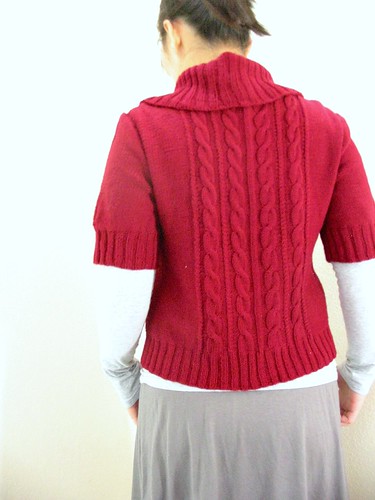Yarn: Classic Elite One Fifty, 7.5 balls
Needles; #4, (#5, #6 for making cowl neck bigger towards top.)
As far as the silhouette, it was pretty much decided from the beginning, cropped pullover (that's so unusual for me these days as I'm getting more and more self-conscious of my tummy being older and wider.) I knew it was gonna be short sleeves and folded over cowl neck. Not much improv with this sweater. It came out pretty close to what I'd planned.
I was even pretty clear on the general idea of cable placement I wanted, so I just flipped through the stitch pattern books I have. I did a quick swatch and decided with "Wild Oats" from Super Stitches Knitting" by Karen Hemingway as the middle section, and the "Double Wrapped Braid" from "A second Treasury of Knitting Patterns" by Barbara G Walker for the outer most cables for framing. I love the look of Wild Oats, I think I want to make something else with that stitch pattern again. The Double Wrapped Braid, while a lovely cable pattern, was probably not the best choice of this sweater. The cables seems a bit out of proportion with the rest, a bit too dainty to go well with the other cables.
I like the result. I don't feel that it's too special since it's just a pullover with stitch pattern on it. BUT, one thing I'm sooo happy with the process of making this was that I finally figured out how to calculate set-in sleeves properly. In the past with my own design sweaters I either use seamless construction of raglan, yoke or pick-up stitches at armhole for sleeves or I just somehow winged it with set-in sleeves by guess work and some redo, or even resort to using software programs for the calculations. I was always a bit intimidated by set-in sleeves because I have not found any good explanations on how to calculate it, and I was never comfortable since I didn't know how the calculations works. I almost used pick-up stitches to do the sleeves this time, but remembering the last few sweaters using this method which all came out much wider than I'd like, I was determined to learn the set-in sleeve design. I sat down and googled. I found this excellent article "Ravelling on the Knitted Sleeves" published in Knitty.com by Jenna Wilson. It's a 3 part articles, and long explanations. I suppressed the urge to skimp through. I really wanted to understand the concept and the method. It was such a well-written explanations. I was absolutely thrilled to finally understand how to calculate the armsyce and sleeves perimeter and curves. It was such a great feeling when everything finally made total sense in my head. I love Pythagorean Theorem and many thanks to Mrs. Engle, my geometry teacher, for teaching me the oh so useful theorem. Now I no longer have to avoid designing with set-in sleeves when I really want to. I'm just thrilled, absolutely thrilled. Next I need to learn how to sew nicely, which honestly doesn't interest me much.
A note about the yarn, the dye seemed to run forever when I was rinsing the sweater for blocking. I do like it as a basic yarn, but the running dye thing bothered me a bit. The sweater stretched out somewhat even though I didn't pin it at all, just laid it flat.


Lovely sweater! I must congratulate you, too, on conquering the set-in sleeve calculation. I haven't managed to do that yet :) I do either raglan or pick up/short row/knit down from the armhole. Next I'll try bottom-up, seamless set-in sleeves . . . then maybe I'll try what you did!
ReplyDeleteSharon I.
(Is there a way to post with just name and email?)